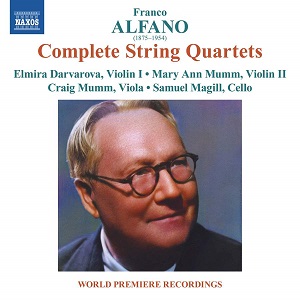
Franco Alfano (1875-1954)
Complete String Quartets
No. 1 in D Major (1914-18 rev. 1924)
No. 2 in Tre Tempi Collegati in C Major (1926)
No. 3 in G Minor (1945)
Elmira Darvarova (violin I), Mary Ann Mumm (violin II), Craig Mumm (viola), Samuel Magill (cello)
rec. 2022, Mount Vernon, USA
Naxos 8.579042 [83]
Naxos extends its ‘19th/20th Century Italian Classics’ series with premiere recordings of these works by the Neapolitan composer, Franco Alfano. His three string quartets are each in three movements. Three previous Alfano-Naxos chamber collections should be mentioned: Piano Quintet; Cello Sonata and Piano Music.
The first two of these roughly half-hour-long quartets date from a period that reached from the Great War to the mid-1920s. The String Quartet No. 1 was premiered in 1921 in Milan amidst the task of orchestrating his opera Sakùntala. Its opening is a Vivacissimo but the word stands feebly in the face of the torrid, angular tumult that is the first movement. It’s as furious and as seethingly lustrous as much of John Foulds’ Quartetto Intimo – a product of a decade later than the Alfano. An implacably melodious and fluently flowing Calmo was written as a memorial to his son who died while serving in the Italian military. It is followed by a Largo-Allegro Deciso. The first particle of this movement is a short extension of the mood of its predecessor but soon says a dry-eyed farewell with writing that is, at first, long on a tungsten determination. This is clearly relished by these four players. The music ends with a noble determination that seems to speak of a will to hold it together.
The String Quartet No. 2, which is ten minutes shorter, has a title which simply signifies that the movements are to be played attacca. It is dedicated to Mussolini, a dictator venerated by Stravinsky and to some degree courted by Puccini, and whose politics were admired by Mascagni and Pizzetti. The work’s tonality is placed under less stress than the First Quartet although it is by no means facile listening. It feels inventive. The second movement is marked ‘like a children’s song’. It is a delicate Thumbelina dance of a blossom. The final ‘danse villageoise’ accelerates all the way through. It comes across as a feral Balkan metamorphosis of Bartók and the middle movement of the Moeran Violin Concerto.
The 1940s dealt blows to Alfano: much of his music was destroyed in the bombing of Turin and his wife died in 1943. It comes as little surprise that the writing of the first movement of the Third Quartet pierces a path into melancholy. Misty-eyed happiness is recalled but clearly it is not to be experienced again. Joy of a sort is grasped in the next movement which has the ecstatic nostalgia of Smetana’s First Quartet moderated and at times even heightened by the language of the Ravel Quartet. This tips over into the melodic complexity of the powerful Allegro finale. Alfano’s final String Quartet had a Rome premiere in 1947.
The CD’s notes could hardly be more needful – and incidentally meeting that need – when the music is otherwise unknown to all but a few. They are by the disc’s cellist, Samuel Magill. The performances are wondrously fervent, hot-house products. The sound is at your throat, heated and upon you with tiger-like ferocity.
Rob Barnett
Help us financially by purchasing from




















